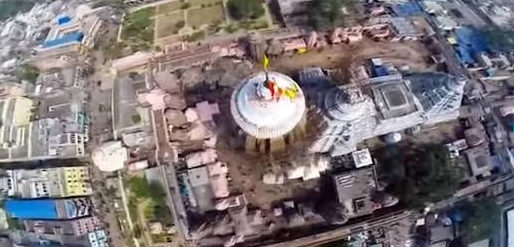- Ancient Origins: The Jagannath Temple, located in Puri, Odisha, India, is one of the most ancient and revered Hindu temples in the country. It has a history dating back over 900 years.

- Dedicated to Lord Jagannath: The temple is dedicated to Lord Jagannath, an incarnation of Lord Vishnu, along with his sister Subhadra and brother Balabhadra. They are worshipped in the temple as the main deities.

- Unique Structure: The temple’s architecture is distinct and unique. It is built in the Kalinga style of architecture, with a towering spire called the “Shikhara” rising to a height of about 214 feet (65 meters). The temple complex covers an area of over 400,000 square feet (37,160 square meters).

- Rath Yatra: The Jagannath Temple is famous for its annual Rath Yatra, also known as the Chariot Festival. During this grand event, the deities are placed on three massive wooden chariots and pulled through the streets of Puri by thousands of devotees. It attracts millions of pilgrims from all over the world.

- Mystery of the Sudarshan Chakra: The temple’s Sudarshan Chakra (a disc-like weapon associated with Lord Vishnu) at the top of the main spire is an intriguing aspect. It is said to be made of an alloy with mysterious and unique magnetic properties, which makes it visible from any point in Puri.

- Mahaprasad: The temple is renowned for its Mahaprasad, the sacred food offered to Lord Jagannath. It is believed that no matter how many people partake in the meal, the food never diminishes. The Mahaprasad is cooked in a traditional kitchen called the “Rosaghara,” which can prepare food for thousands of people simultaneously.

- No Shadow: Another intriguing fact is that the main spire of the Jagannath Temple does not cast a shadow at any time of the day, regardless of the position of the sun. This phenomenon has puzzled scientists and architects for centuries.

- Non-Brahmin Priests: Unlike most Hindu temples where only Brahmin priests perform the rituals, the Jagannath Temple follows a unique tradition. The priests who serve in the temple are from the Panda Brahmin family, and they have hereditary rights to perform the rituals and ceremonies.

- Nilachakra: The temple’s Nilachakra, a giant wheel-shaped ceremonial disc, is made of eight different metals and is hoisted atop the temple’s main spire during special occasions and festivals. It symbolizes the infinite power and protection of Lord Jagannath.

- No Entry for Non-Hindus: Non-Hindus are not allowed inside the temple premises, and they can only view the deities from a distance. This tradition has been in place for centuries to maintain the sanctity and religious practices of the temple.

- Flag Changing Ritual: The flag on top of the main spire, known as the Patitapabana Bana, is changed every day before sunrise in a sacred ritual called “Dwajaparayanam.” It is believed that witnessing this ritual grants salvation to the departed souls.

The Jagannath Temple in Puri is not only a significant religious site but also a marvel of architecture and traditions that continue to captivate people from all walks of life.

